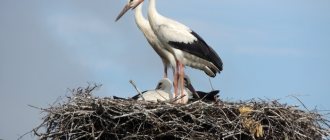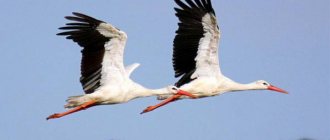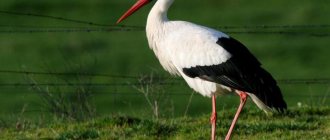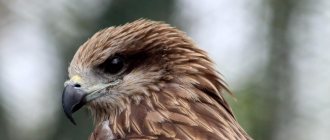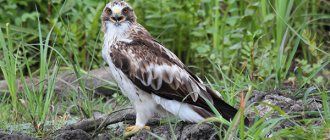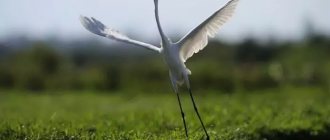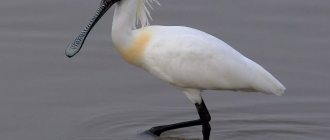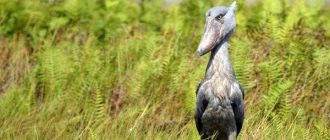- Wild animals
- >>
- Birds
The black stork, unlike its white counterpart, is a very secretive bird. While white storks bring good luck, children and fertility, the existence of black storks is shrouded in mystery. The opinion about the extraordinary small number of the species was formed due to the secretive lifestyle of this bird, as well as due to nesting in the remote corners of untouched forests. If you want to get to know this majestic bird better and learn its habits and way of life, read this article to the end.
Origin of the species and description
Photo: Black Stork
The stork family consists of several genera in three main groups: wood storks (Mycteria and Anastomus), giant storks (Ephippiorhynchus, Jabiru and Leptoptilos) and the "typical storks", Ciconia. Typical storks include the white stork and six other extant species. Within the genus Ciconia, the black stork's closest relatives are other European species + the white stork and its former subspecies, the black-billed eastern white stork of eastern Asia.
Video: Black stork
Naturalist from England Francis Willugby was the first to describe the black stork in the 17th century, after seeing it in Frankfurt. He named the bird Ciconia nigra, from the Latin words for "stork" and "black" respectively. It is one of many species originally described by Swedish zoologist Carl Linnaeus in the landmark Systema Naturae, where the bird was given the binomial name Ardea nigra. Two years later, French zoologist Jacques Brisson transferred the black stork to a new genus, Ciconia.
The black stork is a member of the genus Ciconia, or typical storks. They are a group of seven extant species characterized by straight bills and predominantly black and white plumage. The black stork was long thought to be closely related to the white stork (C. ciconia). However, genetic analysis using cytochrome b DNA hybridization and mitochondrial DNA hybridization by Beth Slikas showed that the black stork was a much earlier branch of the genus Ciconia. Fossils were recovered from the Miocene layer on the islands of Rusinga and Maboko in Kenya, which are not distinguished from white and black storks.
Recommendations
- ^ a b c d f g gram h i j
“
Ciconia nigra
(Black Stork).”
IUCN Red List of Threatened Species
.
2017
. 2022. Retrieved April 27, 2022. - Willoughby, Francis (1681). The Ornithology of Francis Willugby of Middleton in the County of Warwick, Esq.
... London: A.S. for John Martin. p. 286. Archived from the original August 9, 2022. Received February 21, 2022. - Polasek, Andrew (2010). Systema Naturae 250 - Linnaean Ark
. Boca Raton, FL: CRC Press. paragraph 34. ISBN 978-1420095029. - Lewis, Charlton Thomas; Kingery, Hugh McMaster (1918). An Elementary Latin Dictionary
. New York: American Book Company. paragraph 126. ISBN 978-0-19-910205-1. - Linnaeus, Karl (1758). Systema naturae per regna tria naturae, classes secundum, ordinal, genera, species, cum characteribus, differentials, synonyms, loci.
Tomus I. Editio decima, transformed (in Latin). Holmiae: (Laurentius Salvia). p. 142. Archived from the original September 27, 2015. Received July 6, 2022. - Brisson, Mathurin Jacques (1760). Ornithology;
ou, Méthode contenant la division des oiseaux en ordres, divisions, genres, espéces & leurs varés. &c Volume 1 [
Ornithology;
or the division of birds into orders, orders, genera, species and varieties, etc. ] (PDF) (In French). Paris: CJB Bauche. p. 48. Doi:10.5962 / bhl.title.51902. rotate clockwise to page 91 of 802 in PDF link - "Stork". Merriam-Webster. Archived from the original June 10, 2011. Retrieved December 1, 2010.
- Kahl, M. Philip (1987). "Review of Storks of the World." Colonial waterfowl
.
10
(2): 131–134. Doi:10.2307/1521251. JSTOR 1521251. - Wood, D. Scott (1984). "Concordance between classifications of Ciconiidae based on behavioral and morphological data". Journal of Ornithology
.
125
: 25–37. Doi:10.1007/BF01652936. S2CID 32520110. - Slikas, Beth (1997). "Phylogeny of the avian family Ciconiidae (storks) based on cytochrome sequences and DNA-DNA hybridization distances." Molecular phylogenetics and evolution
.
8
(3): 275–300. Doi:10.1006/mpev.1997.0431. ISSN 1055-7903. PMID 9417889. - Liu, Mengyao; Kang, Chunlan; Yang, Chaochao; Huang, Ting; Song, Xuhao; Zhang, Xiuyue; Yue, Beeson; Zeng, Tao (2 January 2016). "Phylogenetic analysis of the black stork Ciconia nigra (Ciconiiformes: Ciconiidae) based on the complete mitochondrial genome." Mitochondrial DNA
.
27
(1):261–262. Doi:10.3109/19401736.2014.883616. ISSN 1940-1736. PMID 24571406. S2CID 29890119. - Dykes, Gareth J.; Alexander, Cyril Walker (2008). "New evidence on fossil 'waterfowl' from the Miocene of Kenya". American Novitates Museum
.
3610
: 1–10. CiteSeerX 10.1.1.1001.5321. Doi:10.1206/0003-0082 (2008) 3610 [1:nrofwf]2.0.co; 2.HDL:2246/5906. ISSN 0003-0082. - ^ a b c d f g gram h i j k l m p
Cramp 1977, p. 323. - Dementyev Georgy Petrovich; Institution, Smithsonian Institution; (USA), National Science Foundation (1966). Birds of the Soviet Union: (Birds of the Soviet Union)
. Jerusalem: Israel Scientific Translation Program. paragraph 406. - Stevenson, Terry; Fanshawe, John (2001). A Field Guide to the Birds of East Africa: Kenya, Tanzania, Uganda, Rwanda, Burundi
. Elsevier Science. paragraph 28. ISBN 978-0856610790. - Ali, Salim; S. Dillon, Ripley (1979). Handbook of the Birds of India and Pakistan
.
1
. New Delhi, India: Oxford University Press. pp. 102–104. ISBN 978-0195659344. - Sinclair, Ian (2006) [1995]. Sasol South African Birds: A Photographic Guide
. Cape Town, South Africa: Struik. paragraph 32. ISBN 978-1770072442. - ^ a b c d f f
McKinnon, John Ramsay;
McKinnon, John; Philipps, Karen; He, Feng-qi (2000). A Field Guide to the Birds of China
. Oxford: Oxford University Press. item 243. ISBN 978-0198549406. - ^ a b c d e g gram h i j k l m p o p q r s t u v w x y
Hancock, James;
Kushlan, James A.; Kahl, M. Philip (2010). Storks, ibises and spoonbills of the world
. London: Bloomsbury Publishing. pp. 70–74. ISBN 978-1408134993. - Bambaradeniya, Channa N. B. (2009). Illustrated Atlas of Wildlife
. Berkeley: University of California Press. paragraph 47. ISBN 978-0520257856. - Convulsion 1977, paragraph 322.
- ^ a b c
Cano Alonso, Luis Santiago;
Franco, Claudia; Pacheco, Carlos; Reis, Susana; Rosa, Gonzalo; Fernandez-Garcia, Manuel (2006). “Breeding population of the black stork. Ciconia nigra
in the Iberian Peninsula" (PDF).
Biota
.
7
(1/2): 15–23. Archived (PDF) from the original July 30, 2022. Retrieved July 12, 2022. - ^ a b c
“Black Stork” (PDF).
Second draft of the South African Bird Atlas
. Department of Animal Demography, University of Cape Town. Archived (PDF) from the original January 6, 2011. Retrieved July 12, 2022. - ^ a b
Bobek, Miroslav;
Humpl, Radek; Peschke, Lubomir; Poyer, Frantisek; Shimek, Yaroslav; Buresh, Stanislav (2008). "The African Odyssey Project - Satellite Tracking of Black Storks. Ciconia nigra
reproduction on a migratory watershed."
Journal of Avian Biology
.
39
(5):500–506. Doi:10.1111/j.0908-8857.2008.04285.x. - ^ a b c d
Pande, Satish;
Pavashe, Amit; Deshpande, Prashant; Sant, Niranjan; Kasambe, Raju; Mahabal, Anil (2007). "Recent data, review of wintering distributions, habitat selection and associations of the black stork ( Ciconia nigra
) in India and Sri Lanka."
Biota
.
7
(1–2): 65–75. - Harrison, John (2011) [1999]. A Field Guide to the Birds of Sri Lanka
. Oxford: Oxford University Press. paragraph 36. ISBN 978-0-19-958566-3. - Robson, C.R.; Buck, H.; Farrow, D. S.; Fisher, T.; King, B. F. (1998). "Birdwatching visit to the Chin Hills, Western Burma (Myanmar), with notes from nearby areas" (PDF). Fork
.
13
: 109–120. Archived (PDF) from the original March 4, 2016. Retrieved July 9, 2022. - ^ a b
World Association of Zoos and Aquariums. "Reintroduction of the black stork". Archived from the original on July 26, 2022. Retrieved July 26, 2022. - Dymond, J. N.; Fraser, P.A.; Gantlett, S. J. M. (2010). Rare Birds in Great Britain and Ireland
. London: Bloomsbury Publishing. pp. 40–41. ISBN 978-1408139622. - Tom, Valerie M. (2010) [1986]. Birds in Scotland
. London: Bloomsbury Publishing. paragraph 90. ISBN 978-1-4081-3835-9. - Qashqai Ali Turk; Dibadge, Parham; Sadekhpur, Shahrokh; Jomepur, Mehdi; Aslani, Javad; Colnegary, Mahmoud; Gholami, Jafar; Akefi, Hamid; Sakhi, Ibrahim; Alavi, Mohammad; Nejat, Farshad; Ardani, Panteja; Babaki, Setareh; Piruz, Reyhane Saberi; Ashariuon, Ashkan; Ahmadzadeh, Faraham (2017). "Further breeding records of the black stork Ciconia nigra
in Iran."
Hazel grouse
.
39
: 48–52. - Firouz, Eskandar (2005). Complete fauna of Iran
. London: I. Tavridy. paragraph 120. ISBN 978-1850439462. - Perrins, Christopher M.; Elphick, Jonathan (2003). The Complete Encyclopedia of Birds and Bird Migration
. Edison, NJ: Chartwell Books. pp. 93–94. ISBN 978-0785816676. - ^ a b
Elkins, Norman (2010).
Weather and bird behavior
. UK: A&C Black. pp. 179–180. ISBN 978-1408128220. - ^ a b c
Finlayson, Clive (2010).
Birds of the Strait of Gibraltar
. London: Bloomsbury Publishing. paragraph 33. ISBN 978-1408136942. - ^ a b
Juana, Eduardo de;
Garcia, Ernest (2015). Birds of the Iberian Peninsula
. USA: Bloomsbury Publishing. pp. 162–163. ISBN 978-1472905918. - Thomsen, Peter; Jacobsen, Peder (1979). Birds of Tunisia: An Annotated Checklist and Practical Guide to Birdwatching
. Copenhagen: nature-travel. pp. 17–18. ISBN 978-8798076414. - Chevalier, Damien; Le Maho, Yvonne; Brossault, P.; Bayon, Francois; Massemyn, Sylvie (2011). "Use of stopover sites by Black Storks ( Ciconia nigra
) migrating between Western Europe and West Africa based on satellite telemetry data."
Journal of Ornithology
.
152
(1):1–13. Doi:10.1007/s10336-010-0536-6. S2CID 21513063. - ^ a b c d
Cramp 1977, p. 326. - ^ a b
Cramp 1977, p. 327. - Rasmussen, Pamela S.; Anderton, John S. (2005). Birds of South Asia.
Ripley's Guide. Volume 2 . Washington, DC and Barcelona: Smithsonian Institution and Lynx Edicions. paragraph 63. - Anonymous (2017). RSPB Pocket Birds of Britain and Europe
. London: Dorling Kindersley Limited. paragraph 133. ISBN 978-0241302781. - ^ a b c d f f
Pottz, Liselotte;
Barovski, Anatoly (2016). Black stork - White shadow
(in German). Digital edition. paragraph 3. ISBN 978-3956557491. - Bag, Peter (2000). "Form and function of aerial courtship displays in the black stork Ciconia nigra." Acrocephalus
.
21
: 223–229. - Lyhmus, Asko; Sellis, Urmas (2003). “Nest trees are a limiting factor for the Black Stork ( Ciconia nigra
) population in Estonia” (PDF).
Aves
(1–4): 84–91. Archived (PDF) from the original July 30, 2022. Retrieved July 10, 2022. - Vlachos, Christos G.; Bakaloudis, Dimitrios E.; Alexandru, Olga G.; Bontzorlos, Vasileios A.; Papacosta, Malamati A. (2008). "Factors influencing nesting site selection of the black stork Ciconia nigra in Dadia Lefkimi Soufli National Park, northeastern Greece." Folia Zoologica
.
57
(3):251–257. - Dresser, Henry Iles (1881). History of the Birds of Europe: Including all the Species Inhabiting the Western Paleactic
. author. clause 8. - Zielinski, Piotr (2002). "Brother Reduction and Parental Infanticide - White Stork" Ciconia ciconia
and Black Stork
C. nigra
exceptional?
"(PDF). Acta Ornithologica
.
37
(2): 113–119. Doi:10.3161/068.037.0207. Archived from the original on August 9, 2022. Retrieved February 14, 2011. - Tamás, Eniku (1 January 2011). "Longevity and survival of the black stork Ciconia nigra based on ring extracts." Biology
.
66
(5). doi:10.2478/s11756-011-0090-6. ISSN 1336-9563. - ^ a b c
Sidorovich, Vadim (2016).
Nalibok Forest: Wild Animals
. Belarus: Chatyry Khvertsy. pp. 494–498. ISBN 978-9855810354. - Sitko, J.; Heneberg, P. (2015). "Composition, structure and pattern of helminth communities associated with Central European storks (Ciconiidae)". Parasitology International
.
64
(2): 130–134. doi:10.1016/j.parint.2014.11.004. PMID 25462710. - Fernández-Garayzábal, J. F.; Vela, A.I.; Egido, R.; Hutson, R.A.; Lanzarot, M. P.; Fernández-García, M.; Collins, M. D. (2004). « Corynebacterium ciconiae
sp.
nov., isolated from the trachea of black storks ( Ciconia nigra
)."
International Journal of Systematic and Evolutionary Microbiology
.
54
(6):2191–2195. doi:10.1099/ijs.0.63165-0. PMID 15545457. - Kaleta, E.F.; Mikami, T.; Marshall, H.-J.; Heffels, Ursula; Heidenreich, M.; Styburek, B. (1980). "A new herpes virus isolated from black storks (Ciconia Nigra)". Pathology of birds
.
9
(3): 301–310. Doi:10.1080/03079458008418415. ISSN 0307-9457. PMID 18770269. - Ilieva, Mikhaela (22 June 2009). "Checklist of chewing lice (Insecta: Phthiraptera) from wild birds in Bulgaria". Zootaxa
.
2138
(1):1–66. Doi:10.11646/zotaxa.2138.1.1. ISSN 1175-5334. - Lanzarot, M. P.; Martín-Mateo, M.P.; Merino, S.; Fernandez-Garcia, M. (December 23, 2005). "Redescription of Neophilopterus tricolor (Burmeister, 1838) (Insecta: Phthiraptera: Ischnocera: Philopteridae) from the black stork Ciconia nigra (L.) (Aves), with notes on its distribution." Journal of Natural History
.
39
(39):3471–3480. Doi:10.1080/00222930500392766. ISSN 0022-2933. S2CID 86148714. - Bloszyk, Jerzy; Gwiazdowicz, Dariusz J.; Holliday, Bruce; Dolata, Paweł T.; Goldyn, Bartlomiej (2009). "Nests of the black stork Ciconia nigra
as habitat for mesostigmatid mites (Acari: Mesostigmata)" (PDF).
Biology
.
64
(5):962–968. Doi:10.2478/s11756-009-0146-z. S2CID 34665485. Archived (PDF) from the original February 7, 2022. Retrieved July 22, 2017.
Quoted texts
- Cramp, Stanley, ed. (1977). Handbook of the Birds of Europe, the Middle East and North Africa: Birds of the Western Palaearctic
. Volume 1: Ostrich for ducks. Oxford: Oxford University Press. ISBN 978-0-19-857358-6 .CS1 maint: ref=harv (communication)
Appearance and features
Photo: Black stork in Estonia
The black stork is a large bird, from 95 to 100 cm long with a wingspan of 143 - 153 cm and weighing about 3 kg, the height of the bird can reach 102 cm. It is slightly smaller than its white counterpart. Like all storks, it has long legs, an elongated neck and a long, straight, pointed beak. The plumage is all black with a purplish-green glossy tint, except for the white underparts of the chest, belly, armpits and wing flaps.
The breast feathers are long and shaggy, forming a kind of ruff. Both sexes are identical in appearance, except that males are larger than females. Young black storks do not have the same rich colors on their feathers, but these colors become vibrant by one year.
Fun fact: Juveniles resemble adult birds in plumage, but the areas corresponding to the adult's black feathers are browner and less shiny. The wings and upper tail feathers have pale tips. The legs, beak and bare skin surrounding the eyes are grayish-green. It can be confused with the juvenile stork, but the latter has lighter wings and mantle and longer and whiter wing flaps.
The bird walks slowly and sedately on the ground. Like all storks, it flies with its neck extended. The bare skin near the eyes is red, as is the beak and legs. During the winter months, the beak and legs turn brownish. Black storks have been recorded to live 18 years in the wild and over 31 years in captivity.
Lifespan
These beautiful birds live up to 31 years in captivity and up to 20 years in the wild. I would like to draw attention to the fact that the main “enemies” that reduce the population are not other predators (large size protects against this), but natural factors. Drying out wetlands and deforestation are the main ones. Since this leads to a reduction in forage areas.
Black Stork
One wonderful “family” lives in one of the zoos in Russia. In the summer she stays in an aviary for poultry, and in the winter she “moves” indoors. In 2014 and 2015, storks bred successfully, feeding 3 chicks each year. The diet of storks is seriously monitored; it is quite varied and consists of 350 grams of meat, 350 grams of fish, two mice and five frogs.
In conclusion of this topic, we can say that now it is becoming increasingly difficult to find old trees where storks could stop and “settle down as a family.” Therefore, the only solution may be to create an artificial nesting park, which local forest districts can do.
In a number of points in Russia, presence at nesting sites has become one of the significant factors in declaring a territory a nature reserve or natural monument. The services that control forest management need to immediately begin to develop acts for the use of rebuilt forests in areas where the species is located to consider the schedule and order of people staying in designated areas.
A significant reduction in bird disturbance during the nesting season can help increase the population. A deeper study of the lifestyle of birds and awareness of the whole world will help solve problems with the extinction of this species.
Where does the black stork live?
Photo: Black stork in flight
Birds have a wide geographical distribution range. During the nesting season, they are found throughout the Eurasian continent, from Spain to China. In autumn, individuals of C. nigra migrate south to South Africa and India to winter. The black stork's summer range begins in East Asia (Siberia and northern China) and extends into Central Europe, as far as Estonia in the north, Poland, Lower Saxony and Bavaria in Germany, the Czech Republic, Hungary, Italy and Greece in the south, with outlying populations in central -southwestern region of the Iberian Peninsula.
The black stork is a migratory bird that spends the winter in Africa (Lebanon, Sudan, Ethiopia, etc.). Although some populations of black storks are sedentary, an isolated population exists in South Africa, where the species is more numerous in the east, in eastern Mozambique, and is also found in Zimbabwe, Swaziland, Botswana, and less commonly in Namibia.
Interesting fact: In Russia, the bird is found from the Baltic Sea, to the Urals, through Southern Siberia all the way to the Far East and Sakhalin. Absent in the Kuril Islands and Kamchatka. The isolated population is located in the south, in Stavropol, Chechnya, and Dagestan. The largest population lives in the Middle Pripyat nature reserve, located in Belarus.
The black stork makes its home in quiet wooded areas that are close to water. They build nests high in trees and feed in swamps and rivers. They can also be found in hilly, mountainous areas if there is enough water nearby to find food. Less is known about their wintering range, but these areas are believed to be in wetlands where food is available.
Conservation status
Despite its extensive range, the black stork is certainly a rare, vulnerable species. In Russia, its numbers are steadily declining, the area of suitable nesting sites is shrinking, and the total number of the species in our country does not exceed 500 nesting pairs. The species is included in the Red Book of Russia and neighboring countries - Ukraine, Belarus, Kazakhstan. There are a number of international bilateral agreements on the protection of the black stork (with Japan, Korea, India, China).
What does the black stork eat?
Photo: Black stork from the Red Book
These birds of prey find food by standing in the water with their wings spread. They walk unnoticed with their heads down to see their prey. When a black stork spots food, it throws its head forward, grabbing it with its long beak. If there is little prey, black storks tend to hunt on their own. Groups form to take advantage of the abundant food resources.
The diet of black storks mainly includes:
- frogs;
- acne;
- salamanders;
- small reptiles;
- fish
During the breeding season, fish makes up the majority of the diet. It may also feed on amphibians, crabs, sometimes small mammals and birds, as well as invertebrates such as snails, earthworms, molluscs and insects such as water beetles and their larvae.
Foraging occurs primarily in fresh water, although the black stork may occasionally forage on land. The bird patiently and slowly wanders through the shallow water, trying to shade the water with its wings. In India, these birds often feed in mixed-species flocks with the white stork (C. ciconia), white-necked stork (C. episcopus), demoiselle crane (G. virgo) and bar-headed goose (A. indicus). The black stork also follows large mammals such as deer and livestock, presumably to eat invertebrates and small animals.
Features of character and lifestyle
Photo: Bird black stork
Known for their calm and secretive behavior, C. nigra are very cautious birds, tending to stay away from human habitations and any human activity. Black storks are solitary outside the breeding season. It is a migratory bird that is active during the day.
Interesting fact: Black storks move along the ground at a steady pace. They always sit and stand upright, often on one leg. These birds are excellent “pilots”, flying high in warm air currents. In the air, they keep their head below the line of their body, stretching their neck forward. Apart from migration, C. nigra do not fly in flocks.
Typically found alone or in pairs, or in flocks of up to one hundred birds during migration or in winter. The black stork has a wider range of vocalizations than the white stork. His main sound he makes is like a loud inhale. This is a hissing sound as a warning or threat. Males display a long series of squealing sounds that increase in volume, and then the sound pressure decreases. Adults may bang their beaks as part of a mating ritual or in anger.
By moving their bodies, birds try to interact with other members of the species. The stork places its body horizontally and quickly tilts its head up down to about 30° and back again, prominently highlighting the white segments of its plumage, and this is repeated several times. These movements are used as a greeting between birds and - more energetically - as a threat. However, the solitary nature of the species means that threat displays are rare.
Social structure and reproduction
Photo: Black stork chicks
Ciconia nigra breed annually in late April or May. Females lay 3 to 5 white oval eggs per clutch in large nests made of sticks and mud. These nests are often reused over many seasons. Parents sometimes carelessly care for birds from other nests, including young egg-eating eagles (Ictinaetus malayensis), etc. They nest solitarily, pairs are scattered across the landscape at a distance of at least 1 km. This species can occupy the nests of other bird species such as the Kaffir eagle or hammerhead and usually reuse the nests in subsequent years.
When courting, black storks display aerial displays that appear unique among storks. Paired birds take off in parallel, usually over the nest territory early in the morning or in the evening. One of the birds spreads its white lower tails and the pair calls to each other. These courtship flights are difficult to see due to the dense forest habitat in which they nest. The nest is built at a height of 4–25 m. The black stork prefers to build a nest on forest trees with large crowns, placing it far from the main trunk.
Interesting fact: The black stork takes 32 to 38 days to hatch its eggs and up to 71 days before the young plumage emerges. After fledging, the chicks remain dependent on their parents for several more weeks. Birds reach sexual maturity when they are 3 to 5 years old.
Males and females share care of the young generation and build nests together. Males look closely at where the nest should be and collect sticks, dirt and grass. Females build a nest. Both males and females are responsible for incubation, although females are usually the primary incubators. When the temperature in the nest becomes too high, the parents will occasionally bring water in their beaks and splash it on the eggs or chicks to cool them. Both parents feed the young. The food is regurgitated onto the floor of the nest and young black storks will feed on the bottom of the nest.
Natural enemies of black storks
Photo: Bird black stork
There are no well-established natural predators of the black stork (C. nigra). Humans are the only known threat to black storks. Much of this threat is due to habitat destruction and hunting.
The black stork is much less common than the white one. Their numbers have declined greatly since the mid-19th century due to hunting, egg removal, intensified forest management, loss of trees, drainage of scrub forests and forested swamps, riots in Horstplatz, and collisions with power lines. Recently, numbers in Central and Western Europe have begun to gradually recover. However, this trend is under threat.
Interesting fact: Scientists believe that the black stork harbors more than 12 types of helminths. The dominant species have been reported to be hian Cathaemasia and Dicheilonema ciconiae. Juvenile black storks were shown to harbor fewer helminth species, but the intensity of infection was higher in chicks than in adults.
Black storks are themselves predators of small vertebrates in the ecosystems in which they live. They hunt mainly aquatic life such as fish and amphibians. The temperature of the black stork's digestive tract allows the fluke to complete its life cycle. The fluke is usually found in its primary host, a fish species, but is ingested by C. nigra during feeding. It is then passed on to the chicks through feeding.
Interesting fact
- People wanted to crossbreed black and white storks and put them in a zoo. There were precedents when a male black stork showed signs of attention to white females. But the attempt to breed a hybrid species was unsuccessful.
- The black stork is considered an endangered species due to its "secrecy". Therefore, it was included in the Red Books of the CIS countries and regions of Russia.
- In the nest, the black stork sleeps, inspects the territory, cleans its feathers, and eats. It also serves as a “sound alarm” when an enemy approaches and trains its wings.
- In Poozerie, a trend towards an increase in the population of black storks was recorded. It is believed that this is due to the deforestation of nearby forest areas. Because of this, birds nest only in the most remote corners of the region.
- The black stork differs from the white stork in its choice of nesting site; the black stork has never built a nest near people. But in recent years, individuals have appeared on the territory of Belarus, nesting near settlements and agricultural lands.
Population and species status
Photo: Bird black stork
Black stork numbers have been declining for many years in Western Europe. This species has already been exterminated in Scandinavia. The population of India, the main wintering destination, is inexorably decreasing. The bird used to regularly visit the Mai Po swamps, but is now rarely seen there, and overall population declines have been observed throughout its Chinese range.
Its habitat is changing rapidly across much of Eastern Europe and Asia. The main threat to this species is habitat degradation. The area of suitable habitat available for breeding is declining in Russia and Eastern Europe due to deforestation and destruction of large traditional nesting trees.
The black stork is threatened by hunters in some countries in southern Europe and Asia, such as Pakistan. Breeding populations there may be destroyed. The black stork has disappeared from the Ticino River valley in northern Italy. In 2005, black storks were released into the Lombardo del Ticino park in an attempt to restore the population.
The population is also threatened by:
- rapid development of industry and agriculture;
- dam construction;
- construction of facilities for irrigation and hydroelectric power production.
Winter habitats in Africa's wetlands are further threatened by agricultural conversion and intensification, desertification, and pollution caused by concentrations of pesticides and other chemicals. These birds are sometimes killed by collisions with power lines and overhead cables.

